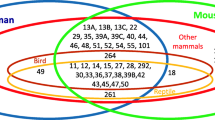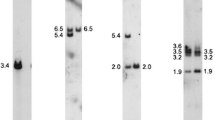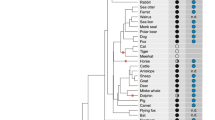Abstract
We have characterized a novel mouse gene (D17Si11) on chromosome 17 that expresses a major transcript observed uniquely in the testes. TheD17Si11 locus has been mapped to the central region of chromosome 17 betweenH-2 andC3. Sequence analysis demonstrates several unusual features of this locus and its transcript: first is the presence of complementary sets of alternating purine and pyrmidine residues within the 3′ region of the transcript that could form double-stranded, hairpin-like secondary structures with properties similar to that of Z-DNA; second is the existence of a hypothetical, long open reading frame in the nucleotide strand that is complementary to the testes transcripts. This complementary strand open reading frame is three times the size of the longest potential open reading frame present in the transcript itself. Although a function forD17Si11 has yet to be determined, the gene is relatively non-polymorphic in mice and appears conserved in mammals.
Similar content being viewed by others
References
Adelman, J. P., Bond, C., Douglass, J., and Herbert, E.: Two mammalian genes transcribed from opposite strands of the same DNA locus.Science 235: 1514–1517, 1987
Artzt, K., Shin, H.-S., and Bennett, D.: Gene mapping within the T/t-complex of the mouse. II. Anomalous positions of the H-2 complex in t-haplotypes.Cell 28: 471–476, 1982
Bibbins, K. B., Tsai, J.-Y., Schimenti, J., Sarvetnick, N., Zoghbi, H. Y., Goodfellow, P., and Silver, L. M.: Human homologues of two mouse t-complex-associated loci map to unlinked regions of chromosome 6.Genomics, in press, 1989
Bucan, M., Herrmann, B. G., Frischauf, A.-M., Bautch, V. L., Bode, V., Silver, L. M., Martin, G. R., and Lehrach, H.: Deletion and duplication of DNA sequences is associated with the embryonic lethal phenotype of the t9 complementation group of the mouse t complex.Genes and Development 1: 376–385, 1987
D'Estachio, P., Fein, B., Michealson, J., and Taylor, B. A.: The alpha-globin pseudogene on mouse chromosome 17 is closely linked to H-2.J Exp Med 159: 958–963, 1984
Eicher, E., Cherry, M., and Flaherty, L.: Autosomal phosphoglycerate kinase linked to mouse major histocompatibility complex.MGG 158: 225–228, 1978
Hall, K., Cruz, P., Tinoco, I., Jovin, T. M., and van de Sande, J. H.: ‘Z-RNA’ — a left-handed RNA double helix.Nature 311: 584–586, 1982
Hamada, H. and Kakunaga, T.: Potential Z-DNA forming sequences are highly dispersed in the human genome.Nature 298: 396–398, 1982
Hamada, H., Petrino, M. G., and Kakunaga, T.: A novel repeated element with Z-DNA forming potential is widely found in evolutionary diverse eukaryotic genomes.Proc Natl Acad Sci USA 79: 6465–6469, 1982
Hammer, M., Schimenti, J., and Silver, L. M.: The evolution of mouse chromosome 17 and the origin of t complex inversions.Proc Natl Acad Sci USA, in press, 1989
Helfman, D. M., Fiddes, J. C., and Hanahan, D.: Directional cloning in plasmid vectors by sequential addition of oligonucleotide linkers.Methods Enzymol 152: 349–359, 1987
Herrmann, B., Bucan, M., Frischauf, A.-M., Mains, P., Silver, L. M., and Lehrach, H.: Genetic analysis of the proximal portion of the mouse t complex: evidence for a second inversion within t haplotypes.Cell 44: 469–476, 1986
Kasahara, M., Passmore, H. C., and Klein, J.: A testis-specific geneTpx-1 maps betweenPgk-2 andMep-1 on mouse chromosome 17.Immunogenetics 29: 61–63, 1989
King, T. R., Dove, W. R., Herrmann, B., Moser, A. R., and Shedlovsky, A.: Mapping to molecular resolution in theT toH-2 region of the mouse genome with a nested set of meiotic recombinants.Proc Natl Acad Sci USA 86: 222–226, 1989
Klein, J.:Natural History of the Major Histocompatibility Complex, John Wiley & Sons, New York, 1986
Kozak, M.: Compilation and analysis of sequences upstream from the translational start site in eukaryotic mRNAsNucleic Acids Res 12: 857–872, 1984
Maniatis, T., Fritsch, E. F., and Sambrook, J.:Molecular Cloning: A Laboratory Manual, Cold Spring Harbor Laboratory Press, Cold Spring Harbor, New York 1982
Mann, E. A., Silver, L. M., and Elliott, R. W.: Genetic analysis of a mouse t complex locus that is homologous to a kidney cDNA clone.Genetics 114: 993–1006, 1986
Nadeau, J. H., Phillips, S. J., and Egorov, I. K.: Recombination between thet 6 complex and linked loci in the house mouse.Genet Res 45: 251–264, 1985
Nelson, D. L., Weis, J. H., Przyborski, M. J., Mulligan, R. C., Seidman, J. G., and Housman, D. E.: Metaphase chromosome transfer of introduced selectable markers.J Molec Appl Genet 2: 563–577, 1984
Nordheim, A. and Rich, A.: The sequence (dC-dA)n·(dG-dT)n forms left-handed Z-DNA in negatively supercoiled plasmids.Proc Natl Acad Sci USA 80: 1821–1825, 1983
Rappold, G. A., Stubbs, L., Labeit, S., Crkvenjakov, R. B., and Lehrach, H.: Identification of a testis-specific gene from the mouse t-complex next to a CpG-rich island.EMBO J 6: 1975–1980, 1987
Russell, J. H., Dobos, C. B., Graff, R. J., and Taylor, B. A.: Genetic control of cross-reactive cytotoxic T-lymphocyte responses to a BALB/c tumor.Immunogenetics 14: 263–267, 1981
Sarvetnick, N., Fox, H., Mann, E., Mains, P., Elliott, R., and Silver, L. M.: Nonhomologous pairing in mice heterozygous for a t haplotype can produce recombinant chromosomes with duplications and deletions.Genetics 113: 723–734, 1986
Schimenti, J., Cebra-Thomas, J., Decker, C., Islam, S. D., Pilder, S. H., and Silver, L. M.: A candidate gene family for the mouset complex responder locus responsible for haploid effects on sperm function.Cell 55: 71–78, 1988
Silver, L. M.: Mouse t haplotypes.Annu Rev Genet 19: 179–208, 1985
Silver, L. M., Uman, J., Danska, J., and Garrels, J. I.: A diversified set of testicular cell proteins specified by genes within the mouse t complex.Cell 35: 35–45, 1983
Silver, L. M., Hammer, M., Fox, H., Garrels, J., Herrmann, B., Bucan, M., Herrmann, B., Frischauf, A.-M., Lehrach, H., Winking, H., Figueroa, F., and Klein, J.: Molecular evidence for the rapid propagation of mouse t haplotypes from a single, recent, ancestral chromosome.Mol Biol Evol 4: 473–482, 1987
Smiley, J. R., Steege, D. A., Juricek, D. K., Summers, W. P., and Ruddle, F. H.: A herpes simplex virus 1 integration site in the mouse genome defined by somatic cell genetic analysis.Cell 15: 455–468, 1978
Sorrentino, V., McKinney, M. D., Giorgi, M., Geremia, R., and Fleissner, E.: Expression of cellular proto-oncogenes in the mouse male germ line: a distinctive 2.4-kilobase pim-1 transcripts is expressed in haploid postmeiotic cells.Proc Natl Acad Sci USA 85: 2191–2195, 1988
Spencer, C. A., Gietz, R. D., and Hodgetts, R. B.: Overlapping transcription units in the dopa decarboxylase region ofDrosophila.Nature 322: 279–281, 1986
Vanderberg, J. L. and Klein, J.: Localization of mouse Pgk-2 gene at the D end of the H-2 complex.J Exp Zool 203: 319–324, 1978
Watson, J., Riblet, R., and Taylor, B. A.: The response of recombinant inbred strains of mice to bacterial lipopolysaccharides.J. Immunol 118: 2088–2093, 1977
Williams, T. and Fried, M.: A mouse locus at which transcription from both DNA strands produces mRNAs complementary at their 3′ ends.Nature 322: 275–279, 1986
Willison, K. R., Dudley, K., and Potter, J.: Molecular cloning and sequence analysis of a haploid expressed gene encoding t complex polypeptide 1.Cell 44: 727–738, 1986
Willison, K. R., Kelly, A., Dudley, K., Goodfellow, P., Spurr, N., Groves, V., Gorman, P., Sheer, D., and Trowsdale, J.: The human homologue of the mouse t-complex gene, TCP1, is located on chromosome 6 but is not near the HLA region.EMBO J 6: 1967–1974, 1987
Zarling, D. A., Calhoun, C. J., Hardin, C. C., and Zarling, A. H.: Cytoplasmic Z-RNA.Proc Natl Acad Sci USA 84: 6117–6121, 1987
Author information
Authors and Affiliations
Rights and permissions
About this article
Cite this article
Sarvetnick, N., Tsai, JY., Fox, H. et al. A mouse chromosome 17 gene encodes a testes-specific transcript with unusual properties. Immunogenetics 30, 34–41 (1989). https://doi.org/10.1007/BF02421467
Received:
Issue Date:
DOI: https://doi.org/10.1007/BF02421467




